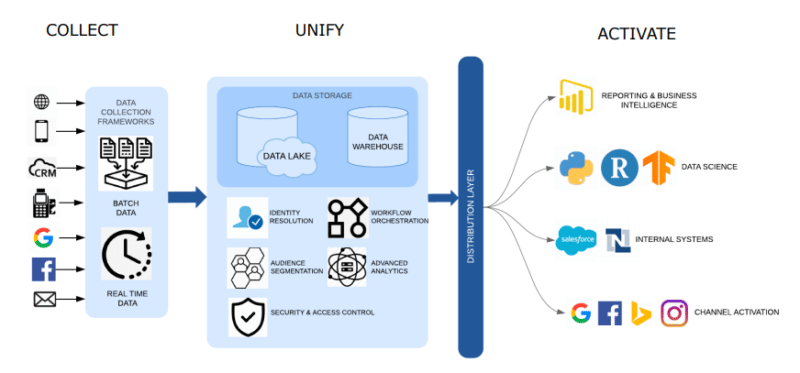Given the changing marketing landscape, having a holistic understanding of customers is essential. This is why more businesses are turning to customer data platforms (CDPs) to help improve their efforts.
“Last year, 2020, just accelerated the digital growth across the world,” said Ekta Chopra, CDO at e.l.f. Beauty, in her recent MarTech presentation. “You’re swimming in data, but 75% of that data is not actionable. 13% is aggregated and everything else is probably not. And 44% of the data is not real-time.”
Storing and collecting vast amounts of customer data isn’t enough. Your organization’s CDP needs to provide actionable insights as well.
Data volume, variety, and velocity
According to Chopra, marketers need a platform that aggregates consumer data and serves as a single source of truth.
“If you do not know the volume, variety, and velocity of your data, you cannot build a solid foundation,” she said. “And then making sure you have the right people that you’re hiring you, that you’re working with the right technical resources and the right insights people that actually know and how to sort of leverage that data to improve everything else in the organization.”

Components of a CDP

The most effective CDPs are much more than data aggregators; they’re data orchestrators. Marketers should choose CDPs that collect, unify, and activate real-time data.
- Data collection: The process where real time data is collected from multiple sources.
- Data unification: Functions that unify data through identity resolution, audience sementation, and security control.
- Data activation: The final stage where unified data is distributed to reporting dashboards, data science and internal systems, and channels for activation.
CDP build or buy?
Marketers have long debated whether buying or building a CDP is the best option for their campaigns. This brings up important questions regarding outsourcing, offshoring, etc. But despite the complexities, it seems the best option for marketers is dependent upon their unique offering.
Chopra believes that companies should be open to purchasing a CDP and only build them if it’s going to serve as their “secret sauce,” a platform that sets them apart from the competition.
Other marketing technology professionals, such as Vijay Mannur of Quantiphi Inc, say building a CDP may be the ideal option going forward. He highlighted the ability to use customized CDP options in a separate MarTech session: “Depending on the evaluated tech stack, we can create a data model that is the best fit for the tech stack that an organization follows.”
Watch the full presentation from MarTech here (free registration required)
Snapshot: Customer Data Platforms
Marketers today face increasing pressure to provide a unified experience to customers across many channels. And these avenues are growing each day. That’s why customer data platforms, or CDPs, have become more prevalent than ever. These help marketers identify key data points from customers across a variety of platforms, which can help craft cohesive experiences.
Cisco’s Annual Internet Report found that internet-connected devices are growing at a 10% compound annual growth rate (CAGR) from 2018 to 2023. COVID-19 has only sped up this marketing transformation. Technologies are evolving at a faster rate to connect with customers in an ever-changing world.
Each of these interactions has something important in common: they’re data-rich. Customers are telling brands a little bit about themselves at every touchpoint, which is invaluable data. What’s more, consumers expect companies to use this information to meet their needs.
Meeting customer expectations, breaking up these segments, and bringing them together can be demanding for marketers. That’s where CDPs come in. By extracting data from all customer touchpoints — web analytics, CRMs, call analytics, email marketing platforms, and more — brands can overcome the challenges posed by multiple data platforms and use the information to improve customer experiences. Learn more here.
The post How to choose and implement a CDP appeared first on MarTech.

0 Comments